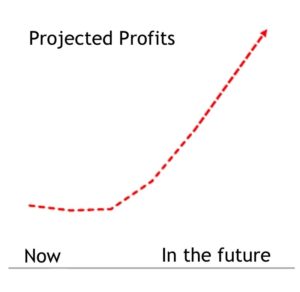The most common mistake in startup business plans is having the profits way too high. There’s no sense whatsoever to priding oneself in projected profits, as in profits you predict your business will have in the future. That’s like having replicas of future Olympic gold medals made and putting them into a trophy case. And in most business settings, it just lowers your credibility. I read 100 or so startup business plans every year, and I’ve getting tired of it. I’ve discovered a new 50-50 rule of profitability in business plans, as in, 50% of the plans I’m looking at project 50% or higher profits on sales.
Pick one: high growth or high startup profits
 In real business, there is inherent conflict between high growth and high profits. That is the collective result of lots of small decisions owners make as they choose to spend marketing money or not. Every dollar you keep in profits is a dollar you didn’t spend to generate growth.
In real business, there is inherent conflict between high growth and high profits. That is the collective result of lots of small decisions owners make as they choose to spend marketing money or not. Every dollar you keep in profits is a dollar you didn’t spend to generate growth.
It’s not just coincidence that the history of high-growth online business successes started with losses. Facebook founder Mark Zuckerberg resisted charging membership fees in the early years, when Facebook was losing money but staying free to users. Sure, later, through advertising, Facebook found a way to make money – but first it had to grow its user base to gain the critical mass that made advertising a practical source of revenue. And Facebook is still free to users. Twitter is still free, struggling to figure out how to make more money, but not even for a second considering charging a fee for participation. LinkedIn is still free, and was free and losing money for years. Revenues came later, after the user base was established.
And even with more traditional businesses on main street, startups are rarely profitable. There are always expenses before launch, and those cut into profits. And few businesses manage to generate revenue to cover costs from the very beginning. Most have a deficit phase as they gain traction and grow.
And as they do establish themselves, they still have to decide, dollar for dollar, whether they spend available money on marketing, or save it and keep it as profits.
Find realistic levels of startup profits
Real businesses make five or 10 percent profits on sales, at best. The NYU business school keeps an updated web page that lists profitability by industry, with an overall average of 6.4%
Occasionally a very successful startup will come up with something so new that it can, for a while, chalk up very high profit margins. That’s extremely rare. Out here in the real world, though, nobody really makes much more than 5-8-10% or so profits on sales. The real startups might make 15% or even 20%.
Projecting 40%, 50%, and even 60% profitability on sales doesn’t tell me you have a great business; it tells me you haven’t done all of your homework. You’re underestimating cost of sales, expenses, or both.
I find this particularly galling in business plans with some social implications, related to health care, or education. I’ve seen many startups planning to sell something offering huge medical benefits to people suffering from serious medical problems, projecting profits of 100 percent or more. Do you agree with me that this is wrong? Nobody chooses to buy these things. Can’t they charge a fair price, that allows a fair profit?
What would I like to see instead? First, find out average profitability for the industry you’re in. Put that number into your plan. Then explain why your company’s projected profitability is higher. Proprietary technology, specialty niche market, new processes? Okay, I can take that; just be aware of what the normal is, so you know what you’re up against. Please.
Standard financials are available from several vendors, for less than $100 per industry (and here I can’t resist adding that they’re bundled with LivePlan, my company’s software product. Sorry. I’m an entrepreneur. I can’t help it.) You can also get those from Oxxford Information Technology, or the Risk Management Association (RMA). And some summary profit by industry data is available for free, from sources such as the NYU page above.




Comments